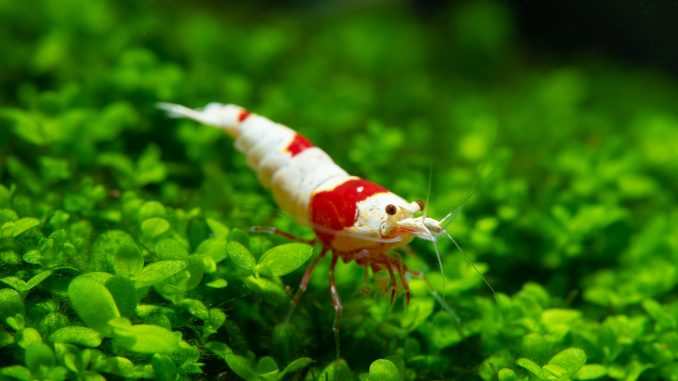
There are many species of freshwater shrimp available for your aquarium, which can make it difficult when you are ready to choose.
A strong contender is the Crystal Red Shrimp. These dwarf shrimps are a wonderful sight in a home aquarium. Though small, their colors and patterns make them stand out.
This species is a particular favorite among breeders. Aquarists often extensively breed them to produce the highest quality individuals that they can.
You don’t need to be a breeder to get some though, everyone will enjoy watching them scuttle around the tank on their endless search for food.
To keep them successfully, a tank’s conditions must be perfect. We will explain everything you need to consider when caring for Crystal Red Shrimp.
TABLE OF CONTENTS
Crystal Red Shrimp Facts & Overview

| Category | Rating |
| Care Level: | Intermediate |
| Temperament: | Peaceful |
| Color Form: | Red and white |
| Lifespan: | 1.5-2 years |
| Size: | 1.2 inches |
| Diet: | Omnivore |
| Family: | Atyidae |
| Minimum Tank Size: | 10 gallons |
| Tank Set-Up: | Freshwater with plants and caves |
| Compatibility: | Species tank or peaceful community |
Crystal Red Shrimp is a popular species of dwarf shrimp for freshwater aquariums. They’re very small but are still packed full of beauty.
They are actually a color variant of the Bee Shrimp (Caridina cantonensis), a member of the Atyidae family, which means their correct scientific name is Caridina cantonensis var. ‘Crystal Red’.
Some areas of Asia simply call them Red Bee Shrimp. This color variety was formed in Japan where they were first selectively bred, but now they are bred around the world.
You won’t find Crystal Red Shrimp in the wild because they are of human creation, but Bee Shrimp is native to Taiwan, which is useful to know when setting up your aquarium.
When buying these shrimps, you need to be aware of grading. This is a rating used to indicate the quality of a shrimp.
The general rules of thumb are that grade goes up with whiteness and opacity. Low grades are mostly translucent red, but high grades have thick white stripes on an opaque red.
As you’d expect, the price of shrimp increases with the grade. This is useful because you can pick some shrimp that fall into your budget. No matter the grade, they will all look great.
Grades range from C-grade to SSS-grade, and the price could range from $5 to $15 per individual as you raise the grade.
Crystal Red Shrimp have a short lifespan in home aquariums. Expect them to survive for 18-24 months, but they need excellent care to reach the 2-year mark.
Typical Behavior
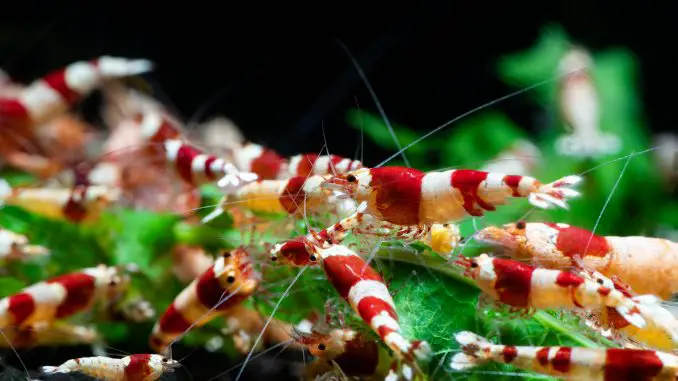
Crystal Red Shrimp are harmless and won’t cause problems for any of their tanks. The opposite can be a problem though, these shrimps are quite vulnerable because they’re so small.
This makes choosing the right tank mates particularly important; we’ll talk about this later.
They spend most of their time at the bottom of the tank, walking across surfaces in search of food.
All shrimp molt regularly. Molting is a process where shrimp shed their old shell in order to grow a stronger one. They must do this because the shell doesn’t grow with the rest of them.
After molting, the shrimp will be particularly vulnerable because it takes a little while for their new exoskeleton to develop and harden. They will probably hide during this time to avoid damage.
Keep an eye on them and try not to move them.
You’ll spot their discarded shell sitting on the substrate. It’s natural to panic, and think it’s a dead shrimp, but you can tell it’s an empty casing when you look closer.
Sometimes the shrimp will eat their old shell for nutrients, but remove it if they don’t because it will pollute the tank as it decays.
Appearance
These shrimps were selectively bred for a reason, these are one of the most attractive species you can buy for your tank.
Broadly speaking, they are stripy red and white but, as we mentioned earlier, this can vary based on their grade.
There are six grades: SSS, SS, S, A, B, and C.
The ‘Low quality’ shrimps in grade C are almost entirely red, with just a few thin white stripes. The ‘high quality’ shrimps are mostly white with smaller red stripes.
The strength of the color influences grades too. A translucent red is less desirable than a powerful, opaque red.
The highest quality Crystal Red Shrimp are called Mosura. These SSS-grade individuals are almost entirely white, they just have bold red patches on their heads and tails.
It is easy to see why this species is classed as dwarf shrimp; they only reach 1.2 inches when fully grown. This makes them particularly vulnerable to being eaten.
They still have all the characteristics of a ‘classic’ shrimp, they’re just shrunken down.
This includes some long antennae, pereiopods (walking legs) under the carapace, pleopods (swimming legs) under the abdomen, and a telson at the end.
It should be easy to sex Crystal Red Shrimp. Females are 10-30% larger and have larger scales on the abdomen. When getting ready to lay eggs, a female’s ovaries are visible in their head and back.
Habitat and Tank Conditions
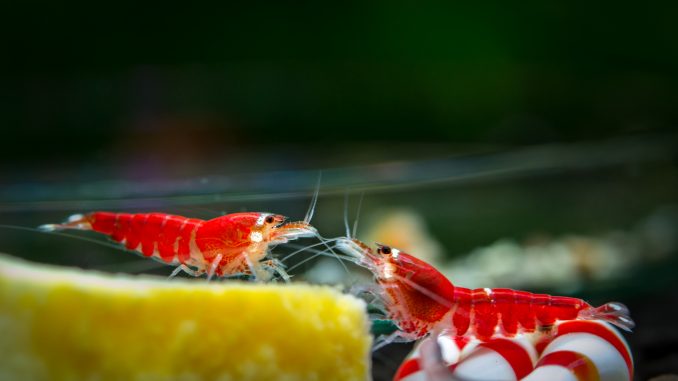
Whenever you’re trying to design a tank for an aquatic pet, the best thing to do is to recreate the conditions they’d be used to in the wild. It makes sense that they’d want similar conditions in captivity.
Crystal Red Shrimp don’t have a natural habitat because they only exist through the selective breeding of Bee Shrimp.
However, you can model the habitat of the Bee Shrimp because they are so closely related.
This would be the freshwater rivers and streams of Taiwan, which the Bee Shrimp is native to. Many shrimp farms have been set up along these rivers because the conditions are perfect.
The waters here are warm and slightly acidic. The slight flow of water ensures that pollutants are flushed away and that there’s plenty of oxygen.
The riverbed would be densely planted and be covered in debris to act as a shelter when needed.
If you can create similar conditions in your aquarium, then your Crystal Red Shrimp should live a long and happy life.
Tank Conditions
This species can be slightly more sensitive to poor water conditions than most other shrimp. Not only are they much smaller, but inbreeding in shrimp farms leaves them much weaker.
Maintaining the right water conditions should, therefore, be a top priority. Use a water testing kit each week to check that the water parameters are where they should be.
Use a heater to keep the temperature between 71°F and 77°F. The pH should be 5.8-7.4.
Layer the bottom of the tank with a soft sandy substrate as this is least likely to scratch. On top of this, you can scatter around various rocks and debris to create caves and hiding spots that your shrimps can use as shelter.
Plants are very important additions to the tank, make sure you have densely planted areas. Grass will be appreciated; you could try Dwarf Hairgrass.
You need a filter to constantly clean the water. The filter outlet should create a sufficient current through the tank, you don’t need a water/air pump. Standard aquarium lighting will be fine too.
What Size Aquarium Do They Need?
These are very small shrimp, but they enjoy having plenty of space in their planted aquariums, so a 10-gallon tank is a minimum. The more space you can provide, the better.
It is easier to maintain the water conditions of larger tanks. This could be important since Crystal Red Shrimp are sensitive to changes in their environment.
How Many Can Be Kept Per Gallon?
Each shrimp only needs a couple of gallons to themselves since they only grow to be 1.2 inches. Make sure you have a good-sized tank in the first place though.
Tank Mates
You have the choice between starting a species tank or a peaceful community.
Crystal Red Shrimp are well suited to a species tank because their small size lets you fit many in the tank, and they are very attractive which keeps the tank interesting.
Species tanks are particularly common when keeping higher-grade individuals.
A community tank is another great option because you can have activity in all areas of the tank. You must pick tank mates carefully though.
Dwarf shrimp are viewed as snacks by fish that are big enough to eat them (which is a lot of them). You must pick small, peaceful species that will leave your shrimps alone.
There are many options, you could try Zebra Danios, Neon Tetras, Otocinclus, Cherry Barbs, or guppies, to name a few.
You can mix Crystal Red Shrimp with other invertebrates too. Most shrimp species make good tank mates, as long as they don’t have a reputation for attacking other shrimps.
Most snails are generally harmless, so could be a good fit for your aquarium.
Keeping Crystal Red Shrimp Together
We have already alluded to the fact that these are excellent shrimps for a species tank. They display no aggression towards each other and will happily live side by side.
Even males don’t quarrel with each other, so you don’t need to worry about the ratio of males to females in the tank.
This is particularly useful for anyone looking to breed Crystal Red Shrimp because you can keep a lot in one group.
Diet
As omnivores, Crystal Red Shrimp will plant and animal matter. Most of their time is spent scavenging around for food, even if they’ve just been fed.
Calcium is an important component of what they eat because it helps them to grow and develop strong exoskeletons.
In the wild, their diet might include small insects, larvae, plant detritus, and algae. This is an easy diet to create for your shrimps at home.
Aim to buy the highest quality foods possible to ease the strain on their digestive systems.
Frozen foods are the healthiest options because they have a high nutrient content. Bloodworms are a popular choice.
Dried foods are a convenient choice. You can use sinking pellets and algae wafers.
The problem with dried foods is that they lose many of their nutrients during the manufacturing process, so make sure to supplement them with other things.
Green vegetables are a good way to provide nutrients and vary the diet. You can use leftovers from your kitchen such as broccoli, zucchini, and cucumber.
You could try making some homemade foods with your vegetables.
They only need to be fed once a day. They are small so don’t need much food. They also spend the whole day scavenging so they’ll be able to find food.
Overfeeding can be a problem because these shrimps are particularly sensitive creatures. Eating too much can cause issues, but leftover food can decay and release pollutants too.
Only provide an amount of food that your shrimp can eat in a few hours. If you spot some uneaten food on the substrate, remove it before it can decay. Vacuum gravel cleaners can help with this.
Care
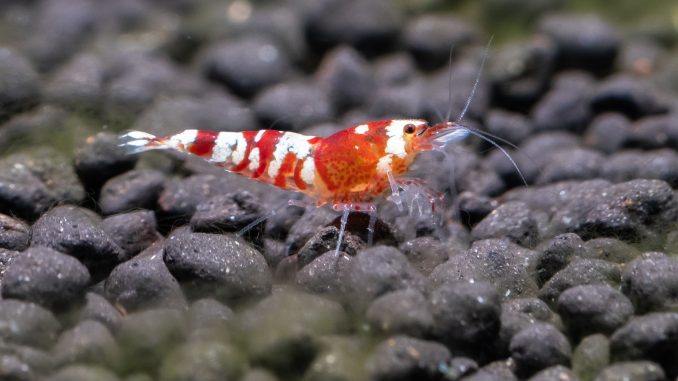
As we’ve already mentioned a couple of times, Crystal Red Shrimp are sensitive animals that need the perfect aquarium to stay healthy. They don’t respond well to sudden changes in their environment.
Their sensitivity likely comes from the intensive inbreeding process that occurs in shrimp farms.
You need to keep the tank as clean as you can. A filter can handle this day today, but you will need to perform regular water changes and wipe away any excess algae.
Keep the substrate clear too. This might mean removing discarded shells from molting or getting rid of uneaten food sat on the surface.
A water testing kit is an important tool to have. Using this each week will help you to spot problems quickly before they can have adverse effects on your shrimps.
If you ever need to add chemicals to the water (e.g. medications), always check that they don’t contain copper. This should be indicated on the bottle. Copper is toxic to virtually all aquarium invertebrates.
If you keep a clean aquarium then disease will be the least of your worries, but Crystal Red Shrimp can get ill just like any other aquatic pet.
This could be through bacterial infection, fungal outbreaks, or parasites. These are often introduced to a tank with new stock from a pet store, so it’s always best to quarantine your new additions.
Even if the shrimps aren’t ill, they can be carriers of common fish diseases that will spread around your community.
Pathogens love poor water conditions, so a healthy setup will keep them at bay. If they do get into your tank, isolate the infected individual, and treat it, there are many medications available ( without copper).
Breeding
Crystal Red Shrimp is one of the most common species to be added to breeding tanks. Aquarists often enjoy trying to produce the highest grade of shrimps they can.
If successful, the high-grade shrimps can be sold from your home to offer a small income.
This species is simple to breed. If the conditions of the tank are right, then they should start mating with little encouragement.
It’s your job to keep the tank clean and monitor the water parameters. Not only do poor conditions affect a shrimp’s health, but they’ll be less likely to breed too.
Make sure that you have a mix of males and females in the tank. Females are slightly bigger and have larger scales on their abdomen. Luckily, males won’t fight so you can have lots of each sex in the tank if you have space.
When ready to mate, the female will release pheromones into the water, which will attract the males.
Before long, females will be carrying eggs around until they hatch after about 30 days. The baby shrimps will emerge fully formed, just much smaller than the parents.
They should be able to look after themselves, but you can feed them some foods specifically designed for baby shrimps if you want to help them develop. These usually come in powdered form.
You’ll need to wait for them to get a bit bigger before you can grade them. Allows the colors and patterns to come through.
Are Crystal Red Shrimp Suitable for your Aquarium?
Since they need the perfect conditions, the safest option might be to design your aquarium around your Crystal Red Shrimp. They can’t be added to any type of environment.
This is definitely the case if you keep large or aggressive fish because these shrimps wouldn’t survive very long. They need small, peaceful tank mates if any at all.
Maintaining the correct water conditions is the hardest part about caring for these shrimps, just because there is little room for error.
Some experience is helpful, but even beginners can be successful if they are willing to put in the effort required for keeping the tank clean. This shouldn’t take up much of your time though.
Keeping Crystal Red Shrimps is very rewarding. You will soon learn why this stunning species has become so popular.

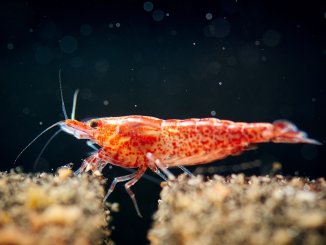
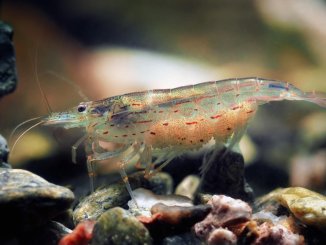
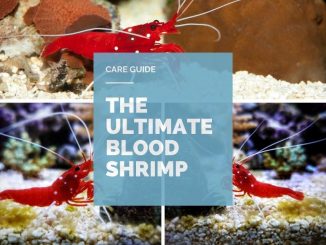
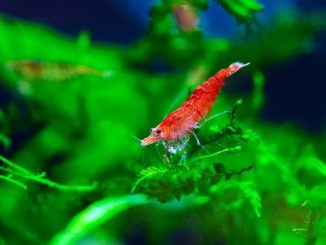
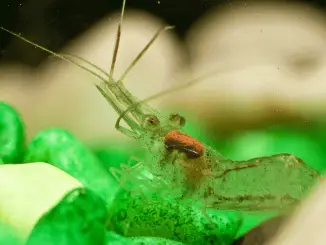
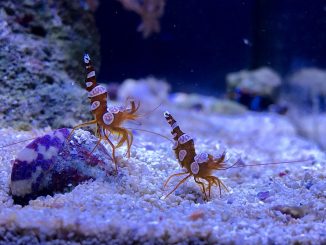
Be the first to comment